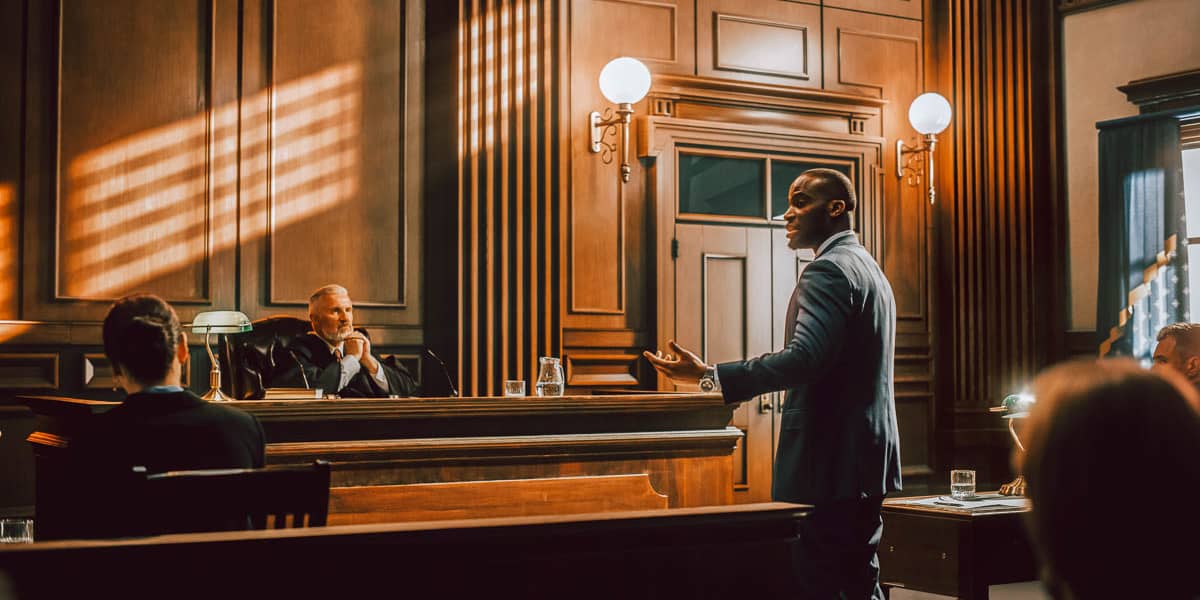Guide to Divorce Court in California

- How do people end up in divorce court?
- How to prepare for trial
- What to expect during your divorce trial
- Alternatives to divorce court
- Hiring a divorce lawyer
- References
Divorce is always complicated. Every item you once shared must be inspected, valued, and given to one person or the other. It's never easy to break a home into two parts, and sometimes, couples can't agree. Divorce court is designed for people who can't end their marriages through collaboration or negotiation.
Few people enjoy California divorce courts. You may have caring judges and exceptional lawyers, but you're still required to discuss your marriage specifics in front of outsiders. It's embarrassing, costly, and time-consuming.
It's often best to work closely with your spouse, settle your estate, and end your marriage outside of a courtroom. But if all other options fail, you can go to a California divorce court and ask a judge to intervene. Here's what you need to know about the process.
How do people end up in divorce court?
A divorce trial can take a year or longer to complete. By contrast, a collaborative divorce could be finished in about six months. Few people want an extended, expensive battle to end their marriage. But sometimes, it's the only option left.
During a divorce, you must settle the following issues with your spouse:
- Child custody
- Child parenting plans
- Child support payments
- Spousal support payments
- Property division
- Asset distribution
- Debt allocation
Some people work through these issues one by one during California’s mandatory six-month waiting period for divorce. They hold meetings, trade proposals, and eventually come to an agreement.
But some people disagree about one or several of these issues. No matter how much they negotiate or how many people attempt to help them, they can’t craft acceptable terms.
For people in this situation, a divorce trial is the only way to end negotiations and settle their estates. The judge’s rulings are final, putting an end to longstanding arguments and disagreements.
How to prepare for a trial
Several steps are required for a California divorce trial. Typically, you'll need a lawyer's help to finish these steps and represent you when the trial starts.
To prepare for trial, you must complete the following steps:
Step 1: Set a trial date
Your lawyer notifies the court that negotiations have stalled and you need a judge's help to finish your divorce. The court sets a date for the trial. If your county is busy, you could wait months for your hearing.
Step 2: Attend a settlement conference
In some counties, people are required to complete one last attempt at an out-of-court settlement. A judge or experienced attorney attends the conference, and you work through your remaining conflicts. If you can come to an agreement, you don't go to trial. If you don't agree, the court case moves forward.
Step 3: Gather evidence
During your trial, you give the judge reasons to rule for your preferred solution. Preparing evidence can help you understand if your position is strong enough to help you win.
For example, if you're arguing for full custody of your children, your evidence might include the following:
- Current report cards
- Physical examinations of the children
- Psychiatric examinations of the children
You'll consider people who could give evidence for you in court. Teachers, religious leaders, doctors, or therapists could all help you make your case. If you want them to come to court, your lawyer will issue a subpoena to compel them to appear.
Read: Could a Nesting Custody Arrangement Benefit Your Family after Divorce?
Step 4: Ask for documents
Your spouse may have documents or data you need to make your case in court. Use a formal process called discovery to ask your spouse to provide the information you need. A lawyer typically handles this step.
Step 5: Prepare your testimony
In most divorce cases, people take the stand to discuss their divorce and preferred outcome. You won't give a speech, but you'll rehearse answers to questions your lawyer and your spouse's lawyer might ask.
Step 6: File a trial brief
Many courts require lawyers to compile a document with the basic facts of their case and the issues they want to discuss. This trial brief is typically due at least five days before the trial starts, and you must serve a copy to your spouse.
What to expect during your divorce trial
The person who asked for the trial typically starts first. They present their side of an issue to the court, introducing witnesses and evidence to support their claims and demands. The other side can counter with questions for witnesses, and they then present an alternative option with their own evidence and witnesses.
You will go back and forth in this manner until you've examined each issue holding up your divorce. Then, a judge will issue final orders both verbally and in writing. You'll sign the final documents in the courtroom and take them to the clerk for filing. The final step to your divorce is complete when you’ve filed those papers.
Experts recommend watching another divorce trial before yours starts. You’ll learn where people typically sit, how testimonials work, and how the judge runs the proceedings.
Ask the clerk in your courthouse for a schedule of trials you can watch. Your lawyer may have good ideas, too.
Alternatives to divorce court
You're not required to end your marriage in a courtroom. Plenty of options exist that can help you collaborate with your spouse, settle your affairs, and come to an acceptable divorce settlement. These are a few of your choices:
Try mediation
A mediator is trained to help two arguing sides settle their differences and agree. Multiple mediation types exist, but most of them involve getting both sides into one room to discuss each point and negotiate a settlement.
Mediators are impartial, and they rarely offer solutions. Instead, they work as conversation facilitators and referees, helping you to understand what your spouse wants and what you need. At the end of a successful session, you could have a signed California divorce agreement ready to file with the courts, allowing you to skip a trial.
Consider collaborative law
In the California collaborative law process, you and your partner agree to stay out of the courtroom during your divorce. You both hire lawyers experienced in collaborative law, and you work together to find a solution to the problems blocking your divorce.
Collaborative law is similar to mediation, but your lawyer advocates for your side. You can stay relatively silent during this process and let your lawyer speak for you.
Use limited-scope representation
You're not required to use a lawyer for every divorce detail. California's limited-scope representation option allows you to handle some parts of your case while a lawyer completes others. You'll stay out of the courtroom with this option while relying on an expert to draw up fair settlements.
For example, you and your spouse could struggle to agree on a fair property distribution. You want to keep the family home, but your partner wants too much money in a buyout. A lawyer could perform a detailed assessment of your home's value and propose a solution based on similar California cases. Your lawyer could present this to your partner along with the supporting documents. This researched packet is likely more compelling than anything you said alone.
Limited-scope representation could keep your costs down while ensuring you get the legal help you need to end your marriage fairly.
Hiring a divorce lawyer
If all other options fail and you must go to divorce court, you likely need a lawyer. These professionals can offer very targeted help that could protect your interests during the trial. While a divorce lawyer is the most expensive option, it’s necessary in some cases.
A lawyer can do the following:
- Prepare you for your trial
- Examine other options (such as settlements) to keep you out of court
- Choose evidence and witnesses for your court case
- Create your trial brief and handle other technical details
Your county's lawyer referral service can help you find local assistance for your case. Search for that person on the State Bar of California's website to make sure they are in good standing. You can also ask friends for referrals if they’ve been through a divorce recently.
Schedule an interview with your top candidates before making a final decision. Consider asking the following questions:
- Have you handled divorce cases like mine in the past?
- What possible outcomes can I expect?
- How long will this last?
- Are there other legal options I should explore before going to trial?
- How do you charge for your time?
- How much can I expect to pay for your help in my divorce?
- Are there ways to shorten the timeline or lower the costs?
You could ask your spouse to cover your legal bills as part of your divorce settlement. But know that many lawyers require upfront payments (or retainers) to accept divorce cases. Asking about money can make you uncomfortable, but it's required when you're hiring a lawyer.
Suggested: Guide to Presenting Evidence in Family Court
References
Divorce Dilemma: Settle or Go to Trial? (February 2020). Forbes.What to Know About a Divorce Trial. Judicial Branch of California.
Prepare for a Divorce Trial. Judicial Branch of California.
Divorce/Dissolution. Superior Court of California, County of Santa Clara.
Work With a Lawyer for Part of Your Case. Judicial Branch of California.
Hire a Lawyer. Judicial Branch of California.


